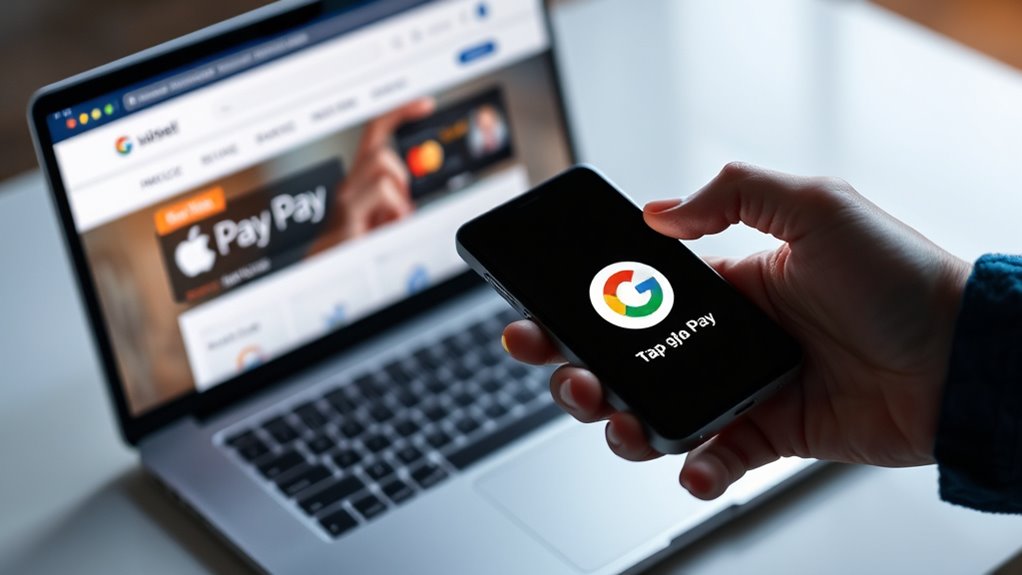To integrate Apple Pay and Google Pay on your website, start by ensuring your site supports HTTPS and works with compatible payment gateways like Stripe, Square, or Braintree. Set up your merchant account, generate the necessary API keys, and follow the provider’s integration guides. Then, add the respective payment buttons with proper code, test across devices, and make sure the checkout experience remains smooth and secure. Continue to explore how to optimize these seamless payment options for your visitors.
Key Takeaways
- Ensure your website uses HTTPS and is compatible with Apple Pay and Google Pay.
- Choose a payment gateway like Stripe, Square, or Braintree that supports these mobile wallets.
- Follow the provider-specific integration guides to embed Apple Pay and Google Pay SDKs or APIs into your checkout flow.
- Add payment buttons according to platform guidelines, displaying them only on compatible devices for a seamless experience.
- Test all integrations across devices and browsers, ensuring security, compliance, and a user-friendly checkout process.

With more consumers adopting mobile payment options, integrating Apple Pay and Google Pay into your business has become essential. These mobile wallets offer a seamless checkout experience that meets customer expectations for speed and convenience. To get started, you need to ensure your website is compatible with these payment methods, which involves working with a payment processor that supports Apple Pay and Google Pay integrations. First, you’ll have to verify that your website uses a secure connection with HTTPS, as both Apple Pay and Google Pay prioritize payment security. This guarantees customer data remains protected during transactions and builds trust with your audience.
Next, you’ll need to set up a merchant account with a payment gateway that supports both services. Many popular providers, like Stripe, Square, or Braintree, facilitate this process, guiding you through the necessary configurations. Once you’ve chosen your provider, you’ll generate the required credentials, such as API keys or certificates, to enable the payment options on your site. Implementing the necessary code snippets or SDKs provided by your payment gateway allows the digital wallets to interact smoothly with your checkout process.
To integrate Apple Pay, you’ll need to add the Apple Pay button to your website, typically using JavaScript and HTML. Apple provides specific guidelines to ensure your implementation aligns with their standards, including displaying the button only on compatible devices. Similarly, for Google Pay, you’ll embed the Google Pay API into your checkout flow, customizing the button’s appearance to match your site’s branding. This integration should be tested thoroughly across different devices and browsers to confirm a consistent experience.
Payment security remains a top priority throughout this process. Both Apple Pay and Google Pay employ tokenization, meaning actual card details aren’t stored or transmitted during transactions. Instead, they generate unique tokens for each purchase, considerably reducing fraud risks. Your role is to ensure your website’s backend securely handles these tokens and complies with PCI DSS standards. Regularly updating your software and monitoring transactions helps prevent potential breaches and maintains customer confidence.
Additionally, incorporating high-quality, high contrast visuals for your payment buttons can improve visibility and user engagement. Finally, communicating these features to your customers can boost their trust and usage. Clearly display the Apple Pay and Google Pay buttons during checkout, and include brief explanations of their benefits, such as quick payments and enhanced security. By making these options visible and easy to use, you encourage more transactions and create a modern shopping experience that aligns with current digital payment trends. Integrating Apple Pay and Google Pay isn’t just about adding new payment methods — it’s about providing a secure, efficient, and user-friendly checkout that keeps your business competitive.
Frequently Asked Questions
Do I Need a Special Merchant Account for These Payments?
Yes, you need a merchant account that supports Apple Pay and Google Pay. Your payment gateway must be compatible with these digital wallets to process transactions securely. Check with your provider if they offer integrated support for these services, or consider opening a merchant account specifically for mobile and contactless payments. This guarantees smooth processing and compliance with security standards, making the checkout experience seamless for your customers.
Can I Use Both Payment Methods on Mobile and Desktop?
Picture yourself browsing on your smartphone or desktop—both devices support Apple Pay and Google Pay seamlessly. Yes, you can use these payment methods on mobile and desktop, thanks to their mobile compatibility and desktop integration. You’ll want to guarantee your website’s payment setup is responsive and properly configured for both environments. This way, your customers enjoy smooth, secure transactions, whether they’re shopping from their phone or sitting at their computer.
What Are the Common Errors During Integration?
You might encounter common errors during integration, such as browser compatibility issues or security considerations. Make sure your website supports the latest browsers to avoid compatibility problems. Additionally, double-check your SSL certificates and payment gateway security settings to prevent security errors. Testing across different devices and browsers helps identify issues early, so you can resolve browser compatibility and security concerns, ensuring smooth, secure transactions for your users.
How Do I Test Apple Pay and Google Pay Before Launch?
You can test Apple Pay and Google Pay before launch by using their sandbox environments, which simulate real transactions without security concerns. Confirm you verify the user experience by completing test purchases, checking for smooth integration and security measures. This way, you identify any issues early, improve the checkout process, and reassure users about their data safety, preventing potential security concerns from affecting your launch.
Are There Any Transaction Fee Differences Between Them?
You might think transaction fees differ between Apple Pay and Google Pay, but they generally don’t. Both use similar fee structures, usually passing on card processing fees to merchants, which are around 2-3%. However, some variations exist depending on your payment processor or country. It’s smart to review each platform’s fee details because specific rates could impact your overall costs, especially with high transaction volumes.
Conclusion
By weaving Apple Pay and Google Pay into your website, you’re gently opening the gates to a smoother, more inviting experience. Imagine your customers strolling through a marketplace where payments flow effortlessly like a gentle breeze, leaving behind the weight of complexity. With these integrations, you’re not just accepting payments—you’re creating a welcoming path that guides your visitors seamlessly to their destination, turning transactions into a harmonious dance of convenience and trust.









